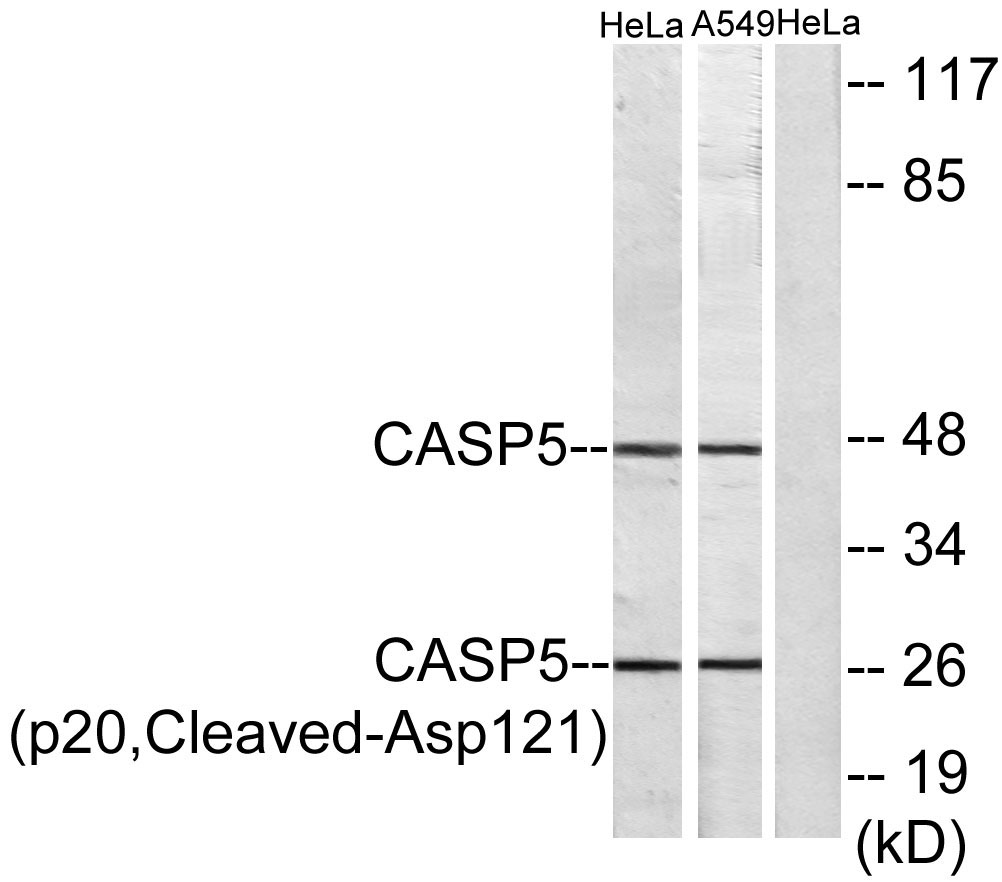Cleaved-Caspase-5 p20 (D121) Polyclonal Antibody
- Catalog No.:YC0031
- Applications:WB;ELISA
- Reactivity:Human;
- Target:
- Caspase-5
- Fields:
- >>NOD-like receptor signaling pathway;>>Salmonella infection
- Gene Name:
- CASP5
- Protein Name:
- Caspase5
- Human Gene Id:
- 838
- Human Swiss Prot No:
- P51878
- Immunogen:
- The antiserum was produced against synthesized peptide derived from human Caspase 5. AA range:102-151
- Specificity:
- Cleaved-Caspase-5 p20 (D121) Polyclonal Antibody detects endogenous levels of fragment of activated Caspase-5 p20 protein resulting from cleavage adjacent to D121.
- Formulation:
- Liquid in PBS containing 50% glycerol, 0.5% BSA and 0.02% sodium azide.
- Source:
- Polyclonal, Rabbit,IgG
- Dilution:
- WB 1:500 - 1:2000. ELISA: 1:20000. Not yet tested in other applications.
- Purification:
- The antibody was affinity-purified from rabbit antiserum by affinity-chromatography using epitope-specific immunogen.
- Concentration:
- 1 mg/ml
- Storage Stability:
- -15°C to -25°C/1 year(Do not lower than -25°C)
- Other Name:
- CASP5;ICH3;Caspase-5;CASP-5;ICE(rel)-III;Protease ICH-3;Protease TY
- Observed Band(KD):
- 22kD
- Background:
- This gene encodes a member of the cysteine-aspartic acid protease (caspase) family. Sequential activation of caspases plays a central role in the execution-phase of cell apoptosis. Caspases exist as inactive proenzymes which undergo proteolytic processing at conserved aspartic residues to produce two subunits, large and small, that dimerize to form the active enzyme. Overexpression of the active form of this enzyme induces apoptosis in fibroblasts. Max, a central component of the Myc/Max/Mad transcription regulation network important for cell growth, differentiation, and apoptosis, is cleaved by this protein; this process requires Fas-mediated dephosphorylation of Max. The expression of this gene is regulated by interferon-gamma and lipopolysaccharide. Alternatively spliced transcript variants have been identified for this gene. [provided by RefSeq, Aug 2010],
- Function:
- catalytic activity:Strict requirement for Asp at the P1 position. It has a preferred cleavage sequence of Tyr-Val-Ala-Asp-|- but also cleaves at Asp-Glu-Val-Asp-|-.,function:Mediator of programmed cell death (apoptosis).,PTM:The two subunits are derived from the precursor sequence by an autocatalytic mechanism.,similarity:Belongs to the peptidase C14A family.,similarity:Contains 1 CARD domain.,subunit:Heterotetramer that consists of two anti-parallel arranged heterodimers, each one formed by a 20 kDa (p20) and a 10 kDa (p10) subunits.,tissue specificity:Expressed in barely detectable amounts in most tissues except brain, highest levels being found in lung, liver and skeletal muscle.,
- Subcellular Location:
- neuron projection,neuronal cell body,IPAF inflammasome complex,NLRP1 inflammasome complex,NLRP3 inflammasome complex,AIM2 inflammasome complex,
- Expression:
- Expressed in barely detectable amounts in most tissues except brain, highest levels being found in lung, liver and skeletal muscle.
- June 19-2018
- WESTERN IMMUNOBLOTTING PROTOCOL
- June 19-2018
- IMMUNOHISTOCHEMISTRY-PARAFFIN PROTOCOL
- June 19-2018
- IMMUNOFLUORESCENCE PROTOCOL
- September 08-2020
- FLOW-CYTOMEYRT-PROTOCOL
- May 20-2022
- Cell-Based ELISA│解您多样本WB检测之困扰
- July 13-2018
- CELL-BASED-ELISA-PROTOCOL-FOR-ACETYL-PROTEIN
- July 13-2018
- CELL-BASED-ELISA-PROTOCOL-FOR-PHOSPHO-PROTEIN
- July 13-2018
- Antibody-FAQs
- Products Images

- Western blot analysis of lysates from HeLa and A549 cells, treated with etoposide 25uM 24h, using Caspase 5 (p20,Cleaved-Asp121) Antibody. The lane on the right is blocked with the synthesized peptide.



